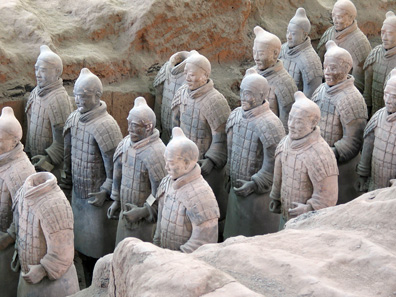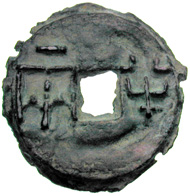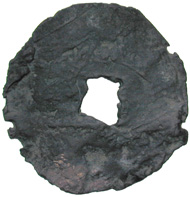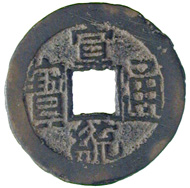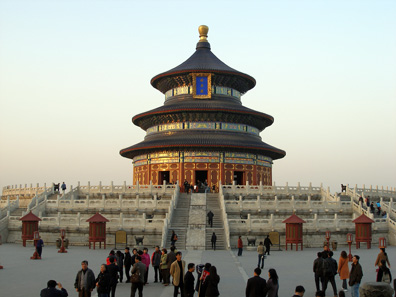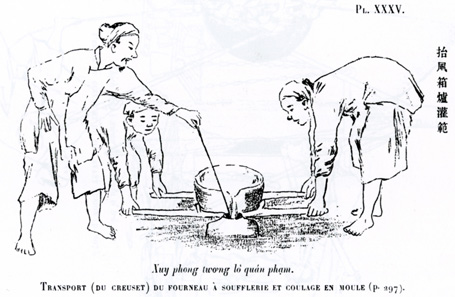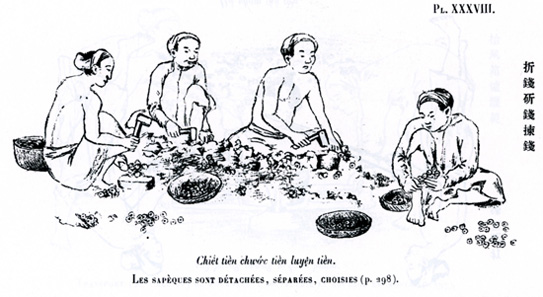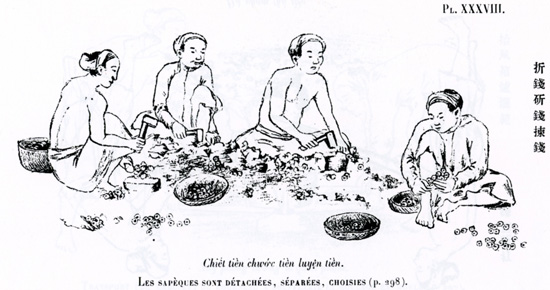Quite rightly, China prides itself of its long history, impressively evidenced by the Chinese monetary tradition that took a different route than our western one. Learn more about the cash.
In 221 B. C., the king of Qin accepted the imperial title. He had managed to unite the entire country under his control so that he deemed the title hitherto used by kings, ‘wang’, not suitable anymore. Qin Shi Huangdi means nothing less than Shining Divine First Emperor of Qin, the eponymous dynasty of China.
Group of soldiers of the terracotta army of Emperor Qin Shi Huangdi in his tomb of Xi’an. Photograph: Nee / Wikipedia. CC 3.0
This ruler we today in the west primarily know thanks to his terracotta warriors, the Chinese revered as founder of their state. They consider him a tyrant, on the one hand, and the initiator of a great unification, on the other hand. He is credited with having built a major part of the Great Wall of China. He divided the empire into equal units that were subordinated to him and controlled by his officials. He introduced a hierarchy for the civil servants where the individual could work his way up to the top. The Chinese say that he had a virtual regulation mania that resulted not only in the unification of the Chinese script and the standardization of all measures and weights but likewise in a a rigid ordinance regarding the hairdo of his soldiers and the regulation that the square official caps of his civil servants had to be exactly six fingers high, the carriages exactly 1.82 m long.
China. Qin Dynastie. Emperor Qin Shi Huangdi (221-210 B. C.), Banliang (= weighing half liang) or – as we today would refer it to – cash. © MoneyMuseum, Zurich.
With that said, it is hardly surprising that Qin Shi Huangdi was credited for a long time for having invented the first cash with a weight of half a liang (i.e. about 8 g). The archaeological finds, however, tell us that the first of these coins had been produced as early as the Warring States Period (453-221 B. C.). Their shape derives from the ring-shaped jade discs that served as ritual presents during the time of the Zhou Dynasty (1027-256 B. C.). There were given to the lieges when they visited the emperor’s palace to deliver the annual tribute.
China. Qing Dynasty. Emperor Puyi (1875-1908), cash. © MoneyMuseum, Zurich.
Qin Shi Huangdi declared the coins used in Qin, where they were called ‘ban liang‘ (= half liang), the only currency allowed to circulate in his empire. And the cash became the most important coin of China indeed, and was minted until the end of the empire under Emperor Puyi.
A cash is a round-shaped bronze coin with a rectangular hole that exhibits characters which state the weights and/or the issuing authority. This coin was a perfect embodiment of the imperial power. Both – coin as well as emperor – connected heaven and earth, yin and yang. The coin, after all, had two sides, and its shape likewise mirrors the principles of male and female: the Chinese philosophers thought that heaven was a dome, simplified as a circle, whereas earth was symbolized by the square. The emperor’s task was to establish peace between heaven and earth with his laws and ask the divine emperor for heavy crop and prosperity.
Temple of Heaven / Beijing. Photograph: Fioshoot / Wikipedia. CC-by-2.0.
The central sanctuary of China, the Temple of Heaven, was a circular building in a square-shaped court – and this symbolism is clearly mirrored in the imperial coins: they are round-shaped with a square hole. The Chinese belief system, therefore, is reflected in the cash which constituted the most important of Chinese money until the 19th century.
Just like our present money, these coins were a ‘fiat currency’, hence a means of exchange whose value wasn’t backed by any noble metal but was valuable only thanks to a joint convention. The way in which these coins were used is explained in a legal document that was found in a tomb in 1975. The regulation, written on bamboo, contains some provisions on economic and currency affairs. And here we read that the ‘round-shaped coins’ were to be used without any distinction, regardless if they were ‘beautiful’ or ‘ugly’ (in plain terms, if they were heavy or light). In addition, it was prohibited to sort these coins according to weight when doing business. That means that this first cash already was a currency that was designed solely as a means of barter, regardless of its intrinsic value, and this was a development that Europe ultimately completed as late as 1968. –
As a matter of fact, other materials than bronze were used for manufacturing money in China, too, – we know specimens made of the inferior metals lead and iron, even made of fabric and paper, in some cases of bamboo or wood.
Let’s get back to the above mentioned law. It informs about the ‘bu’ being used as currency as well, simultaneously with the cash, fabric measuring exactly 188 x 58 centimeters. ‘Bu’ was only accepted as currency when it came in precisely this size. Its value was defined with 11 unsorted coins.
For large sums, in addition, the unit ‘pen’ was used. One ‘pen’ equaled a clay vessel containing exactly 1,000 coins – in 1962, a clay container was found in Zhangpu (Shaanxi Province) actually filled with 1,000 coins which, additionally, still possessed the seal of the market administration of a small community.
At last, a word about the term ‘cash’. Contrary to expectations, it didn’t originate in China, but in India where the word ‘karsha’ meant ‘bronze coin’.
Coining and coin tree
The cash weren’t minted like the western coins but were cast in an expandable mould. First, an important calligrapher created the layout of the new coin that wasn’t decorated with figural representations but with characters only. Even the emperor is said to have designed coins from time to time. Once the model was approved of officially, it was carved in wood, bone or ivory.
The casting moulds for the cash are made with an imprint of a coin in moist clay. From A. Schroeder-Annam, Études numismatiques, Paris (1905), pl. 21.
It served as basic raw material for the first casting mould used to produce the so-called ancestor coins. They were the master moulds, the ones every further coin of the emission was produced with. As a result, they had to be reworked carefully. From these master moulds, new moulds were manufactured from which ‘mother moulds’ were made. These ‘mother moulds’ were sent to local workshops throughout China where yet another moulds were produced used to cast circulation coins.
The finished casting moulds are examined and piled. From A. Schroeder-Annam, Études numismatiques, Paris (1905), pl. 24.
These casting moulds consisted of clay plates piled with several coin moulds that were connected with a cast channel.
Molten bronze is filled in the casting moulds. From A. Schroeder-Annam, Études numismatiques, Paris (1905), pl. 35.
By that, one single casting produced as many coins as were connected by a small strip of solidified metal. And so, the model coin tree was created, symbol of luck and wealth that was a requisite in every burial ceremony to guarantee prosperity to the deceased in the afterlife, too.
The coins are broken off the ‘coin trees’. From A. Schroeder-Annam, Études numismatiques, Paris (1905), pl. 38.
For every-day use these coin trees of course were taken to pieces, and the single cash coins carefully broken off the strip.
The cash coins are counted and strung together on slings by which they became easy to handle. From A. Schroeder-Annam, Études numismatiques, Paris (1905), pl. 40.
After that, they were slung together on slings with which bigger sums would be paid much easier.
By the way, cash wasn’t produced in the official mints exclusively. In those areas that were short on coins, private individuals used circulated specimens to produce cash coins in exactly the same way, and these coins were accepted on the market like any officially sanctioned piece. Already the first Han emperor after the fall of the Qin Dynasty had legalized this custom in 206 B. C.
This large-scale production was needed in order to produce the vast amount of coins China demanded. After all, the single cash coin had lost nearly its entire value. While in the Han Dynasty (206 B. C.-A. D. 220) a horse had cost 4,500 cash, the price rose to 25,000 cash in the 7th century, and during the Mongolian dominion in the 13th century, it had finally arrived at 90,000 cash coins – for just one horse.
Money in Chinese popular belief
In China, cash wasn’t just a means of payment, but played an important role in popular belief as well. The Chinese considered particular coins especially auspicious. Good examples are the so-called ‘Zhou Yuan Tong Bao’.
Originally, they had been cast from the bronze of the statues taken from 3,000 Buddhist temples. The Chinese characters written on them meant ‘everywhere new beginning’ and ‘circulating treasure’. Their owners considered this auspicious to such an extent that they withdrew the coins from circulation and used them as charm or remedy. When, eventually, no real ‘Zhou Yuan Tong Bao’ were circulating anymore, new ones were produced – likewise other lucky charms in coin-shape with special inscriptions were designed. Not everything that looks like a Chinese cash coin in fact is one.
Entire swords were built from coins. They were used to shoo away evil ghosts and illnesses. In the funerary cult, too, coins and later banknotes played an important part. They were given to the deceased as means of payment in the afterlife. FYI, that custom retains until the present day. At present, however, no real banknote is being burnt at the great burial ceremonies but hell money printed by private companies in the name of Hell Bank or Bank of Hades for this purpose only. The printing houses in Hong Kong, by the way, have real fun in giving the king of hell, as the traditional motif on these notes, the facial features of those politicians from west and east that are particularly unpopular at the moment.
The third episode of our trip through the history of Chinese money will take us from the invention of paper money until today.
Numerous examples of the history of Chinese coinage you will find informatively explained on the website of the MoneyMuseum.
Many of these objects in the MoneyMuseum are part of the Kuhn Collection.
You can find all parts of this series here.




